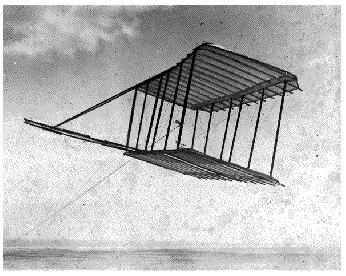1900 Aircraft Interactive
You can study the design of the 1900 aircraft by changing the view using the buttons at the bottom of this JavaScript program.
This simulation shows a computer drawing of the Wright brothers’ 1900 aircraft. This aircraft was flown repeatedly at Kitty Hawk, North Carolina, during the fall of 1900, mostly as a kite but also as a piloted glider. Research directed the Wright brothers to Kitty Hawk because of the constant strong winds which their kite required. The location also had hills for launching the glider if the windspeed was low and abundant sand to soften crash landings.
Please note: the simulation below is best viewed on a desktop computer. It may take a few minutes for the simulation to load.
The Wright Brothers’ Aircraft
Their main goal was to learn how to control the forces on an aircraft. The Wright brothers used the 1900 aircraft to learn the fundamentals of aerodynamics. You can learn the same things in the same way by flying your own kite or glider. It’s fun!
Designing the Aircraft
The Wright brothers had observed that soaring birds twist their wings to change direction. The brothers had successfully done the same thing in Dayton in 1899 by twisting the wings of a small kite. In 1900, the brothers decided to test this idea on an aircraft that was large enough to carry a man. The pilot could control the roll of the aircraft by using a foot pedal. The pedal was connected to wires which pulled on the wing tips and warped, or twisted, the wing. Warping produces unequal forces on the wings which would roll the aircraft.
The 1900 aircraft was relatively large as you can tell by comparing with the size of the pilot. The aircraft had two wings covered by a tightly woven material called “sateen”. Each wing had a seventeen foot span and a five foot chord. Four foot struts separated the wings and a stabilizer was mounted on the front of the aircraft which had no tail. Without the pilot the 1900 craft weighed about fifty pounds. In 1900, glider pilots usually flew in a vertical position. The Wright brothers correctly understood that this produced a lot of aerodynamic drag that would slow a glider down. They chose instead to streamline their aircraft by having the pilot lie horizontal on the lower wing.

All wings have a natural tendency to flip tail over nose because of the pressure distribution around the wing. To prevent their aircraft from flipping, the Wright brothers attached a horizontal stabilizer to the front of the aircraft. A stabilizer at the front of an aircraft is called a canard after the French word for “duck”, since a duck has a bulge around its neck. On later models the shape of the stabilizer was varied by the pilot to provide pitch (up and down) control. But on the 1900 aircraft they fixed the stabilizer in place and just tested the wing warping. They found it too confusing at this early juncture to simultaneously provide both pitch and roll control. On the 1901 aircraft, they would begin experiments on simultaneous control.
For three weeks they flew their craft as a kite, using chain as weight to simulate a pilot and operating the controls by cable from the ground. Then they decided to test the craft as a glider, with Wilbur as pilot. Launching from a dune hill on a very windy day, he made about a dozen glides, some lasting as much as 20 seconds and covering up to 400 feet, longer than a football field! Altogether he spent about 2 minutes in the air. Even though this was the only day that season with winds strong enough to carry a pilot, they showed that wing warping was a success. Lessons learned on the 1900 aircraft were incorporated on all of the later Wright aircraft.
Replica
To celebrate the Centennial of Flight in 2003, many people around the country have built full scale replicas of the Wright 1900. The 6th grade students of the Orono Middle School from Orono, Maine, have donated a full scale model of the aircraft to NASA to share with other students.
